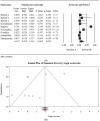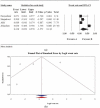The prevalence of antibiotic-resistant Clostridium species in Iran: a meta-analysis
- PMID: 30961444
- PMCID: PMC6493275
- DOI: 10.1080/20477724.2019.1603003
The prevalence of antibiotic-resistant Clostridium species in Iran: a meta-analysis
Abstract
Clostridium species are ubiquitous and associated with various diseases in animals and humans. However, there is little knowledge about the prevalence of their resistance to antibiotics in Iran. Therefore, the aim of this study was to determine the prevalence of antibiotic-resistant Clostridium species in Iran through a meta-analysis of eligible studies published up until December 2018. Fourteen articles on the drug resistance of Clostridium species in Iran were included in the current study following a search in PubMed, Scopus and Google Scholar databases using relevant keywords and screening based on inclusion and exclusion criteria. Antibiotic resistance rates of C. difficile to ampicillin (42.8%), ciprofloxacin (69.5%), clindamycin (84.3%), erythromycin (61.5%), gentamicin (93.5%), nalidixic acid (92.9%), tetracycline (32.5%), imipenem (39.6%), levofloxacin (93.4%), ertapenem (58.7%), piperacillin/tazobactam (56.5%), kanamycin (100%), colistin (100%), ceftazidime (76%), amikacin (76.5%), moxifloxacin (67.9%) and cefotaxime (95%) were high. In addition, resistance of C. perfringens to ampicillin (25.8%), erythromycin (32.9%), gentamicin (45.4%), nalidixic acid (52.5%), tetracycline (19.5%), penicillin (21.8%), trimethoprim-sulfamethoxazole (32.1%), amoxicillin (19.3%), imipenem (38%), cloxacillin (100%), oxacillin (45.6%), bacitracin (89.1%) and colistin (40%) was high. Metronidazole and vancomycin, as the first-line therapies, fidaxomicin, tetracyclines (except tetracycline), rifampicin and chloramphenicol can still be used for the treatment of C. difficile infections. However, the present results do not recommend the use of penicillin, bacitracin and tetracycline for the treatment of C. perfringens infections in humans and domestic animals in Iran.
Keywords: Drug resistance; Iran; meta-analysis.
Figures



Similar articles
-
Systematic Review and Meta-Analysis on the Frequency of Antibiotic-Resistant Clostridium Species in Saudi Arabia.Antibiotics (Basel). 2022 Aug 29;11(9):1165. doi: 10.3390/antibiotics11091165. Antibiotics (Basel). 2022. PMID: 36139945 Free PMC article. Review.
-
Prevalence of fluoroquinolone-resistant Salmonella serotypes in Iran: a meta-analysis.Pathog Glob Health. 2020 Feb;114(1):16-29. doi: 10.1080/20477724.2020.1719701. Epub 2020 Feb 4. Pathog Glob Health. 2020. PMID: 32013798 Free PMC article.
-
Antimicrobial susceptibility of Clostridium difficile from different sources.Microbiol Immunol. 1982;26(1):25-30. doi: 10.1111/j.1348-0421.1982.tb00150.x. Microbiol Immunol. 1982. PMID: 7087801
-
Antibiotic resistance of Clostridium perfringens isolates from broiler chickens in Egypt.Rev Sci Tech. 2013 Dec;32(3):841-50. doi: 10.20506/rst.32.2.2212. Rev Sci Tech. 2013. PMID: 24761735
-
The ClosER study: results from a three-year pan-European longitudinal surveillance of antibiotic resistance among prevalent Clostridium difficile ribotypes, 2011-2014.Clin Microbiol Infect. 2018 Jul;24(7):724-731. doi: 10.1016/j.cmi.2017.10.008. Epub 2017 Oct 21. Clin Microbiol Infect. 2018. PMID: 29066403
Cited by
-
Antimicrobial potential of myricetin-coated zinc oxide nanocomposite against drug-resistant Clostridium perfringens.BMC Microbiol. 2023 Mar 22;23(1):79. doi: 10.1186/s12866-023-02800-5. BMC Microbiol. 2023. PMID: 36949384 Free PMC article.
-
Systematic Review and Meta-Analysis on the Frequency of Antibiotic-Resistant Clostridium Species in Saudi Arabia.Antibiotics (Basel). 2022 Aug 29;11(9):1165. doi: 10.3390/antibiotics11091165. Antibiotics (Basel). 2022. PMID: 36139945 Free PMC article. Review.
-
Prevalence and antimicrobial resistance pattern of Clostridium difficile among hospitalized diarrheal patients: A systematic review and meta-analysis.PLoS One. 2022 Jan 13;17(1):e0262597. doi: 10.1371/journal.pone.0262597. eCollection 2022. PLoS One. 2022. PMID: 35025959 Free PMC article.
References
-
- Murray PR, Rosenthal KS, Pfaller MA.. Medical microbiology. 8th ed. UK: Elsevier Health Sciences; 2015. p. 234–242.
-
- Nasiri MJ, Goudarzi M, Hajikhani B, et al. Clostridioides (Clostridium) difficile infection in hospitalized patients with antibiotic-associated diarrhea: A systematic review and meta-analysis. Anaerobe. 2018;50:32–37. - PubMed
-
- US Department of Health and Human Services Antibiotic resistance threats in the United States, 2013. Centers for Disease Control and Prevention; 2013April23.
Publication types
MeSH terms
Substances
LinkOut - more resources
Full Text Sources
Medical
